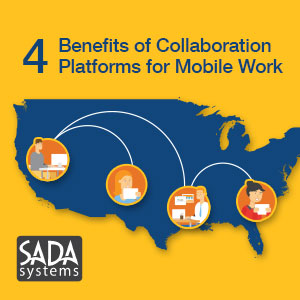
Mobile work, completed across dispersed teams, is fast becoming the norm. Smart devices have raised expectations for accessibility—both internal (colleagues) and external (clients). One study found 79% of knowledge workers now work frequently, or always, within dispersed teams. And having a collaboration platform is now more important than ever.
And already, by 2012, Forrester found that with some employees working from client sites was common, with between a quarter to over a third of employees working from some mobile location (whether on client sites, while traveling, from public sites, or from home).
These trends are only continuing. The number of traditional employees who now work mobile (at least part of the time) has increased 115% since 2005. And over the last five years, 40% more U.S. are now offering mobile work policies and providing flexible workplace options.
Organizations are embracing mobile work for one simple reason: It produces tangible benefits—for the organization, for teams, and for individual employees.
If you pair mobile work with the right collaboration platform, you can leverage these four key benefits.
1. Increased Productivity Over Office-Only Workers with a Collaboration Platform
A recent report by Aon Consulting found that “well-managed dispersed teams can actually perform those that share office space.” In some organizations, introducing mobile work increased productivity by up to 43%.
The reasons for this increased productivity are many. Mobile work increases communication, collaboration, and alignment between colleagues—the three largest causes of productivity loss, according to 86-97% of employees. And the savvy creation of mobile teams in different time zones can produce an organization that works 24/7.
Mobile work also helps employees make better use of their time. Google reports users of Google Docs have been able to cancel at least 2-5 hours of meetings a week ‘by collaboratively solving problems ahead of time” within their collaboration platform. Mobile work turns small pockets of downtime during the day into opportunities to complete small tasks. Mobile employees often use their smartphones to answer short emails and other messages while they wait for a meeting to start, while they wait at the airport, or during their commute.
2. Decreased Organizational Silos
Traditional modes of work create silos between colleagues. Many organizations are split between staff that work on-site with clients, and in-office staff who support them. Employees who work “in the field”, but with different clients, may never meet each other. Industries like retail and hospitality and manufacturing create two clear workspaces—front of house, and back of house. And even within traditional office plans, employees on opposite sides of the corporate campus may never interact.
Mobile work solves many of these problems. Video chat brings dispersed teams face-to-face. Real-time document editing allows colleagues to co-create company content, regardless of where they are located. And cloud-based applications like Google+, Google Hangouts, G-Drive, and Google Sites make it easier for employees to connect over a shared company, and interpersonal, culture by sharing personal notes, photos, and links.
3. Blurred Lines Between Colleagues, Clients, and Collaborators
Accenture recently noted that the new mobile, dispersed, and collaborative workplace does not apply only to internal teams. Organizations are changing their operating models, and beginning to use new tools to bring in many groups—including the organization’s internal staff, contractors, vendors, and more—to reach their goals. In these new models, the lines between the different groups are blurring. As Accenture explains, “workforces are becoming combinations of internal, external, and contingent employees.”
Google recently shared a case study that exemplifies this trend. The advertising agency M&C Saatchi has begun to use Google Drive as a central home for their design files, from which both the agency’s internal staff, and their clients, review, edit, add comments, and co-create their creative—all without having to transfer files, or deal with other barriers between the organizations.
4. Direct Financial ROI
And finally, the big one—The intelligent selection, deployment, and management of mobile work via a cloud-based collaboration platform has been shown to directly improve an organization’s bottom line.
In a recent study, Forrester spent three years measuring the total economic impact of “organizations moving from legacy on-premise infrastructure to Google’s web-based solution.”
What did they find? Over the three years of the study, G-Suite produced a risk-adjusted $17.1 million in benefits, versus the total costs of $4.2 million, resulting in a risk-adjusted ROI of 304% for the organizations that deployed the platform. The study found that, within only three years, G-Suite gave the studied organizations an average of $8 million in collaboration efficiencies, $9 million in mobility benefits and legacy IT cost savings, and an ROI of $1,708 per employee.
Bring These Benefits to Your Organization
At SADA Systems, we work everyday to transform organizations through innovative cloud-based solutions. As a Google Cloud Premier Partner, SADA Systems has proven expertise in enterprise consulting, cloud platform migration and deployment, custom application development, managed services, user adoption, and change management.
Contact SADA today for a free consultation on how to bring the benefits of mobile work and a cloud collaboration platform to your organization.
https://hbr.org/2014/12/getting-virtual-teams-right
https://meticul.com/blog/benefits-of-using-g-suite-for-business-part-1/
https://globalworkplaceanalytics.com/telecommuting-statistics
https://hbr.org/2014/12/getting-virtual-teams-right
https://blog.clearcompany.com/7-workplace-collaboration-statistics-that-will-have-you-knocking-down-cubicles
https://www.technologyreview.com/s/423159/technology-will-make-collaboration-your-next-competitive-advantage/
https://www.computerweekly.com/opinion/Gartner-Benefits-of-mobile-collaboration
https://www.accenture.com/us-en/insight-outlook-how-collaboration-technologies-are-improving-process-workforce-business
https://gsuite.google.com/learn-more/cloud-solutions-professional-services.html
https://gsuite.google.com/learn-more/forrester-tei-report-2015.html



